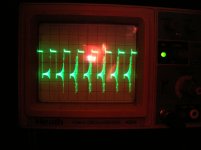Hey All,
Does this look familiar to anyone? At the output of the power tubes it is on top of the square wave of the tube driven by the phase splitter plate and on the bottom for the tube driven by the cathode. The trace is at the output into an 8ohm 20 watt resistor.
Kevin
Does this look familiar to anyone? At the output of the power tubes it is on top of the square wave of the tube driven by the phase splitter plate and on the bottom for the tube driven by the cathode. The trace is at the output into an 8ohm 20 watt resistor.
Kevin
Attachments
Looks like you have yourself an oscillation! Time to start playing with compensation... this will be a learning experience. Do you have a copy of "Building Valve Amplifiers"? There's a very clear description on how to adjust the amp for stability.
Does this look familiar to anyone? At the output of the power tubes it is on top of the square wave of the tube driven by the phase splitter plate and on the bottom for the tube driven by the cathode. The trace is at the output into an 8ohm 20 watt resistor.
Typical negative damping. You've got an instability that's causing that exponentially rising characteristic before it breaks into saturation. You didn't say if there's any NFB connected, or what the frequency is, but that's definitely a sign that you haven't got enough phase margin at the high frequencies.
"Learning experience" sounds like a challenge, and a pain. Yes it has NFB but its driven from the 8 ohm output rather than the 16 in the original design. I'll do some more research at let you know when I fix it.
Kevin
Thanks very much for identifying the problem and pointing me in the right direction!
Kevin
Thanks very much for identifying the problem and pointing me in the right direction!
Hey Guys,
I disconnected the NFB and the oscillation went away. But it was still distorted. It sounded like a blown up woofer with a warped voice coil. So I pulled the OPT off the second amp and I have a square wave output! I just listened to the amp. It sounds pretty good but the Hammond OPT transformer seems to saturate really early. (Eli warned me about this.) I think it's especially a problem because I'm using 6550c's (Svetlana) instead of EL34's. The Hammond site lists this transformer as working with 6550b's. Is there much of a difference? Now I have to decide whether to get one more Hammond or go with a pair of Triode clones.
And Miles, what is phase margin? Is that like magnetic headroom?
Kevin
I disconnected the NFB and the oscillation went away. But it was still distorted. It sounded like a blown up woofer with a warped voice coil. So I pulled the OPT off the second amp and I have a square wave output! I just listened to the amp. It sounds pretty good but the Hammond OPT transformer seems to saturate really early. (Eli warned me about this.) I think it's especially a problem because I'm using 6550c's (Svetlana) instead of EL34's. The Hammond site lists this transformer as working with 6550b's. Is there much of a difference? Now I have to decide whether to get one more Hammond or go with a pair of Triode clones.
And Miles, what is phase margin? Is that like magnetic headroom?
Kevin
Phase margin is a figure of merit that tells you something about the stability of a control/feedback system. Think of phase as delay (though, technically they're slightly different). It takes a certain amount of time for the signal to travel through the amplifier. When the signal is fed back to one of the earlier stages in the amp, it's subtracted from that signal. Now, recall that a sine wave signal is periodic. One period is 360 degrees of phase. So if the signal is delayed by one quarter wave, it's 90 degrees out of phase. Now if the signal is delayed by 180 degrees (corresponding to a complete inversion), when it's subtracted at the feedback point, it will end up in phase with the incoming signal. Hence the two signals will add rather than subtract. That's positive feedback. The signal amplitude will increase until the summing stage limits. The phase margin is the additional amount of phase needed to reach -180 degrees of phase lag through the feedback loop. In other words, it's a measure for how close you are to getting positive feedback.
Does this make sense? It's an intuitive hand-wavy explanation. If you prefer a more scientifically correct explanation, I suggest consulting Wikipedia: Phase margin - Wikipedia, the free encyclopedia
The "magnetic headroom" you're mentioning sounds more like magnetic saturation. It has nothing to do with phase margin but could potentially cause instability. It's a large signal behavior, though. Phase margin deals with small signal behavior. http://en.wikipedia.org/wiki/Magnetic_saturation
~Tom
Does this make sense? It's an intuitive hand-wavy explanation. If you prefer a more scientifically correct explanation, I suggest consulting Wikipedia: Phase margin - Wikipedia, the free encyclopedia
The "magnetic headroom" you're mentioning sounds more like magnetic saturation. It has nothing to do with phase margin but could potentially cause instability. It's a large signal behavior, though. Phase margin deals with small signal behavior. http://en.wikipedia.org/wiki/Magnetic_saturation
~Tom
- Status
- Not open for further replies.
